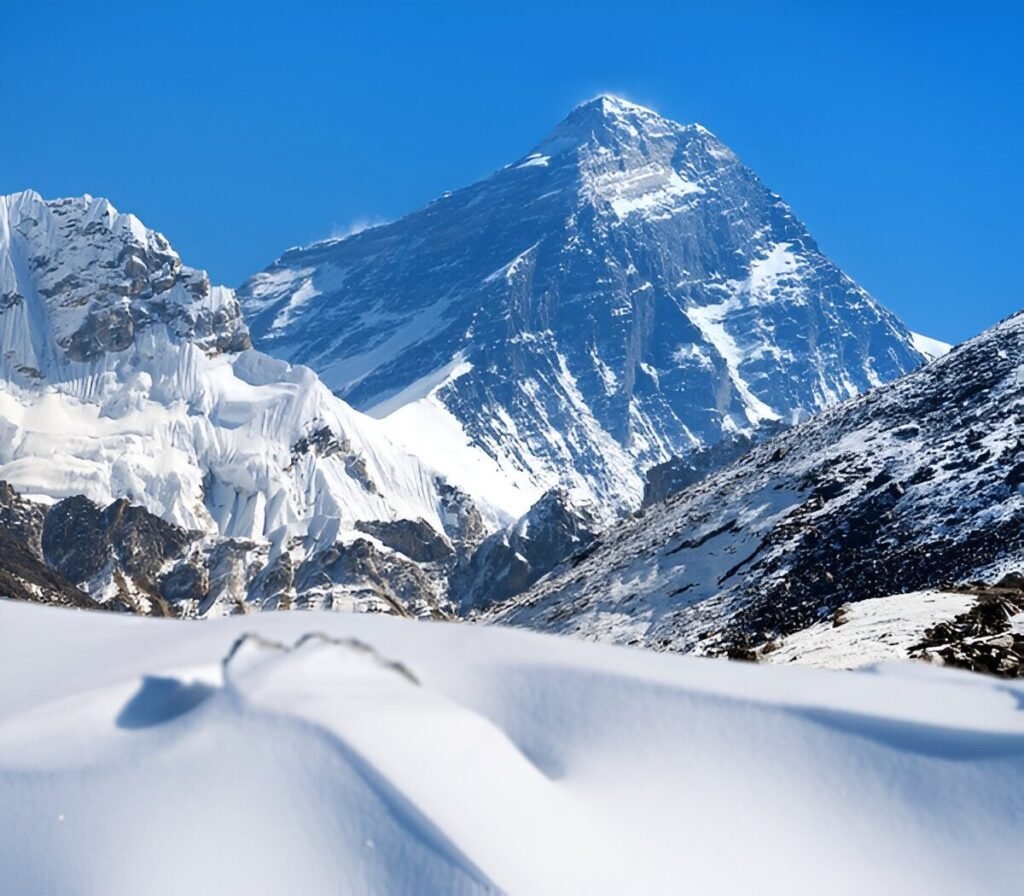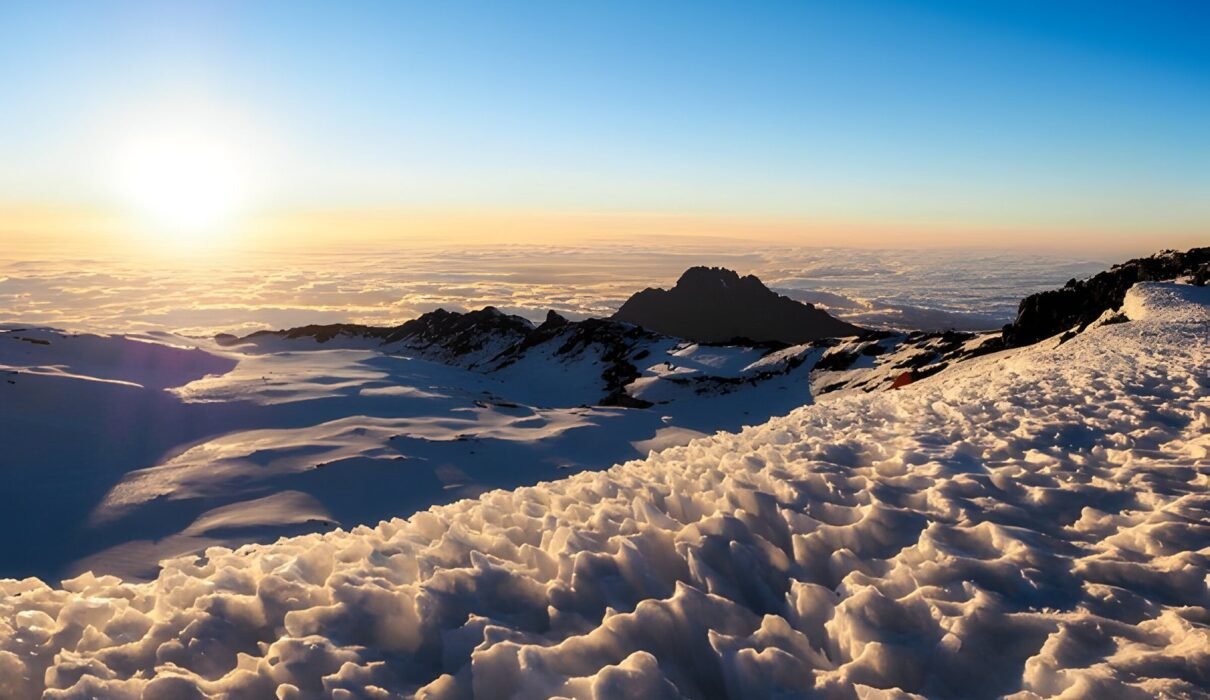Tallest Mountains in The World 2025 : Mountains have always fascinated adventurers and nature enthusiasts, representing the ultimate challenge and the beauty of nature’s grandeur. In 2025, many travelers will still be drawn to the world’s tallest peaks for their sheer size, breathtaking views, and sense of accomplishment that comes with reaching their summits. This guide will take you through the top list of the tallest mountains in the world in 2025, highlighting their remarkable features, ideal trekking seasons, and the unique experiences they offer.
Tallest Mountains in The World 2025 : Mount Everest (8,848.86 meters) – Nepal/China
Still reigning as the tallest mountain in the world, Mount Everest stands at 8,848.86 meters above sea level. Everest, known as “Sagarmatha” in Nepal and “Chomolungma” in Tibet, is a dream climb for many, though it presents significant physical and mental challenges.
Key Features:
- Height: 8,848.86 meters.
- Location: Nepal and Tibet.
- Best time to climb: April to May (pre-monsoon) and September to October (post-monsoon).
Read more about Mount Everest.

Tallest Mountains in The World 2025 : K2 (8,611 meters) – Pakistan/China
Known as the “Savage Mountain,” K2 is the second-highest mountain in the world and is considered one of the most difficult to climb. Standing at 8,611 meters, K2 has a steep ascent and treacherous weather conditions, making it a challenging peak even for experienced climbers.
Key Features:
- Height: 8,611 meters.
- Location: Karakoram Range, on the Pakistan-China border.
- Best time to climb: June to August.
Learn more about K2 and its challenges.
Tallest Mountains in The World 2025 : Kangchenjunga (8,586 meters) – Nepal/India
Kangchenjunga, the third-highest mountain in the world, lies along the Nepal-India border. Known for its striking beauty, Kangchenjunga is a less-frequented but equally majestic peak compared to Everest.
Key Features:
- Height: 8,586 meters.
- Location: Eastern Himalayas, on the Nepal-India border.
- Best time to climb: April to May.
Discover more about Kangchenjunga.
Tallest Mountains in The World 2025 : Lhotse (8,516 meters) – Nepal/China
Lhotse is the fourth-highest mountain in the world and is often overshadowed by its neighbor, Everest. At 8,516 meters, Lhotse shares much of the same climbing route as Everest up to Camp 3, making it a popular secondary goal for climbers on an Everest expedition.
Key Features:
- Height: 8,516 meters.
- Location: Mahalangur Himalayas, along the Nepal-China border.
- Best time to climb: May to October.
Tallest Mountains in The World 2025 : Makalu (8,485 meters) – Nepal/China
Makalu, the fifth-highest mountain at 8,485 meters, is known for its sharp, pyramid-shaped summit. The mountain presents a tough technical climb, often requiring a high level of experience with alpine techniques.
Key Features:
- Height: 8,485 meters.
- Location: Mahalangur Range, between Nepal and China.
- Best time to climb: April to May.
Read more about climbing Makalu.
Tallest Mountains in The World 2025 : Cho Oyu (8,188 meters) – Nepal/China
At 8,188 meters, Cho Oyu is the sixth-highest mountain in the world. It’s considered one of the easier 8,000-meter peaks to climb, making it a popular choice for climbers preparing for more difficult ascents like Everest.
Key Features:
- Height: 8,188 meters.
- Location: Mahalangur Range, on the Nepal-China border.
- Best time to climb: September to November.
Learn more about Cho Oyu expeditions.
Tallest Mountains in The World 2025 : Dhaulagiri (8,167 meters) – Nepal
Dhaulagiri, standing at 8,167 meters, is the seventh-highest peak in the world. Located in the Himalayas of north-central Nepal, Dhaulagiri is often overshadowed by the nearby Annapurna Range, though it offers a more remote and challenging climb.
Key Features:
- Height: 8,167 meters.
- Location: Western Nepal.
- Best time to climb: April to May and September to October.
Read more about Dhaulagiri expeditions.
Tallest Mountains in The World 2025 : Manaslu (8,163 meters) – Nepal
Manaslu, the eighth-highest mountain in the world, is part of the Mansiri Himal in the Nepalese Himalayas. Manaslu is known for its stunning scenery, and it offers a less commercialized climb compared to Everest and other high peaks.
Key Features:
- Height: 8,163 meters.
- Location: Nepal.
- Best time to climb: March to May and September to November.
Find out more about Manaslu treks.
Tallest Mountains in The World 2025 : Nanga Parbat (8,126 meters) – Pakistan
Nicknamed “The Killer Mountain” due to its treacherous conditions, Nanga Parbat is the ninth-highest peak in the world at 8,126 meters. It is located in Pakistan’s Gilgit-Baltistan region and is considered one of the most difficult mountains to climb due to its steep faces.
Key Features:
- Height: 8,126 meters.
- Location: Gilgit-Baltistan, Pakistan.
- Best time to climb: June to August.
Read more about Nanga Parbat climbs.
Tallest Mountains in The World 2025 : Annapurna I (8,091 meters) – Nepal
Rounding out the list, Annapurna I is the tenth-highest mountain in the world, standing at 8,091 meters. While it’s a beautiful peak located in the popular Annapurna region of Nepal, Annapurna I is known for having one of the highest fatality rates among climbers.
Key Features:
- Height: 8,091 meters.
- Location: Nepal.
- Best time to climb: April to May.
Learn more about Annapurna treks and challenges.
Tallest Mountains in The World 2025 : Mount Kilimanjaro (5,895 meters) – Tanzania
While Mount Kilimanjaro doesn’t make it onto the list of the world’s highest mountains by altitude, it is the tallest free-standing mountain in the world, standing at 5,895 meters. Climbing Kilimanjaro offers a unique experience, as it requires no technical climbing skills, making it accessible to most trekkers.
Key Features:
- Height: 5,895 meters.
- Location: Tanzania.
- Best time to climb: June to October and January to February.
Plan your Kilimanjaro climb with Kilimanjaro Climb Specialist.

Aconcagua (6,962 meters) – Argentina
Aconcagua, the highest peak in the Southern and Western Hemispheres, stands at 6,962 meters and is located in Argentina. It’s a popular destination for climbers looking to ascend the highest peak outside of the Himalayas, and it requires minimal technical skills.
Key Features:
- Height: 6,962 meters.
- Location: Argentina.
- Best time to climb: December to March.
Read more about Aconcagua expeditions.
Mount Elbrus (5,642 meters) – Russia
Mount Elbrus is the tallest mountain in Europe, standing at 5,642 meters. Located in the Caucasus Range in Russia, Elbrus is considered a relatively straightforward climb but still presents its own challenges due to weather conditions and altitude.
Key Features:
- Height: 5,642 meters.
- Location: Russia.
- Best time to climb: June to September.
Discover more about climbing Mount Elbrus.
Vinson Massif (4,892 meters) – Antarctica
Standing at 4,892 meters, Vinson Massif is the highest peak in Antarctica. Climbing Vinson requires logistical challenges due to its remote location, but it is a unique adventure for those looking to experience the icy landscapes of Antarctica.
Key Features:
- Height: 4,892 meters.
- Location: Antarctica.
- Best time to climb: December to January.
Learn more about Vinson Massif expeditions.
Tallest Mountains in The World 2025 : Conclusion
From the legendary heights of Mount Everest to the accessible and scenic trails of Mount Kilimanjaro, the world’s tallest mountains offer some of the most spectacular views and thrilling adventures. Whether you’re a seasoned climber or a trekking enthusiast, these peaks promise experiences that will test your limits and create memories for a lifetime.
For those looking to start their climbing journey, Kilimanjaro Climb Specialist offers tailored trekking packages to Mount Kilimanjaro, perfect for beginners and experienced hikers alike. You can also pair your mountain adventure with a luxury safari by booking with Eddy Tours & Safaris.

